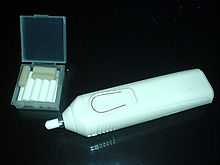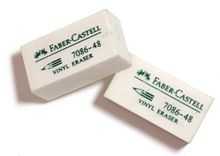Eraser

An eraser (US and Canada) or rubber (India, UK, Ireland, South Africa, Australia and New Zealand) is an article of stationery that is used for removing pencil markings. Erasers have a rubbery consistency and are typically pink or white. Most pencils have an eraser on one end. Typical erasers are made from synthetic rubber, but more expensive or specialized erasers are vinyl, plastic, or gum-like materials. Cheaper erasers can be made out of synthetic soy-based gum.
History

Before rubber erasers, tablets of rubber or wax were used to erase lead or charcoal marks from paper. Bits of rough stone such as sandstone or pumice were used to remove small errors from parchment or papyrus documents written in ink. Crustless bread was used as an eraser in the past; a Meiji-era (1868-1912) Tokyo student said: "Bread erasers were used in place of rubber erasers, and so they would give them to us with no restriction on amount. So we thought nothing of taking these and eating a firm part to at least slightly satisfy our hunger."[1]
On April 15, 1770, Joseph Priestley described a vegetable gum to remove pencil marks: "I have seen a substance excellently adapted to the purpose of wiping from paper the mark of black lead pencil." He dubbed the substance "rubber".[2][3]
In 1770, Edward Nairne, an English engineer, is credited with developing the first widely-marketed rubber eraser for an inventions competition. He sold natural rubber erasers for the high price of three shillings per half-inch cube. According to Nairne, he inadvertently picked up a piece of rubber instead of breadcrumbs, discovered rubber's erasing properties, and began selling rubber erasers. Incidentally, that was the first practical application of the substance in Europe, and rubbing out the pencil marks gave it its English name.
However, raw rubber shared the same inconveniences as bread, since it was perishable. In 1839, inventor Charles Goodyear discovered the process of vulcanization, a method that would cure rubber and make it a durable material. Rubber erasers became common with this advent of vulcanization.
On March 30, 1858, Hymen Lipman of Philadelphia, USA, received the first patent for attaching an eraser to the end of a pencil. It was later invalidated because it was determined to be simply a composite of two devices rather than an entirely new product.[4]
Erasers may be rectangular blocks (block and wedge eraser), or conical caps that can slip onto the end of a pencil (cap eraser). A barrel or click eraser is a device shaped like a pencil, but instead of being filled with pencil lead, its barrel contains a retractable cylinder of eraser material (most commonly soft vinyl). Novelty erasers, in a dual role as figurines (such as musical notes, animals, confectionery), are mostly decorative, as their hard vinyl tends to smear heavy markings.
Types
Art gum erasers

An eraser type that is popular with artists is the art gum eraser, made of soft, coarse rubber. It is especially suited to removing large areas, and it does not damage paper. However, they are imprecise. Gum erasers tend to crumble as they are used, so this type leaves a lot of eraser residue. This residue must then be brushed away with care, as the eraser particles can leave marks on the paper. Many artists use a broad brush to sweep away the loose eraser residue. Art gum erasers are commonly tan or brown, but sometimes are sold in blue.
Kneaded erasers
Kneaded erasers are common to most artists' standard toolkit. This type has numerous uses. They can be pulled into a point for erasing small areas and tight detail erasing, molded into a textured surface and used like a reverse stamp to give texture, or used in a "blotting" manner to lighten lines or shading without completely erasing them. They gradually lose their efficacy and resilience as they become infused with particles picked up from erasing and from their environment. They are weak at erasing large areas, as they deform under vigorous erasing.
Poster putty
Commonly sold in retail outlets with school supplies and home improvement products, this soft, malleable putty appears in many colors and under numerous brand names. Intended to adhere posters and prints to walls without damaging the underlying paint, poster putty works much the same as traditional kneaded erasers, but with a greater tack or lifting strength. Poster putty does not erase so much as lighten by lifting graphite, charcoal or pastel off a drawing. In this regard, it does not smudge or damage work in progress. Repeatedly touching the putty to a drawing pulls ever more medium free, gradually lightening the work in a controlled fashion. Poster putty can be shaped into fine points or knife edges, making it ideal for detailed or painstaking work. It can be rolled across a surface to create visual textures. Poster putty loses its efficacy with use, becoming less tacky as the material grows polluted with debris and oils from the user's skin.
Electric erasers

The electric eraser has a knob in a short thin rod attached to a motor. The eraser knob turns at a uniform speed, achieving a smooth erasure with a minimum of paper trauma. Electric erasers work quickly and completely.
Soft vinyl erasers

Soft vinyl has a plastic-like texture and erases cleaner than standard erasers. They are softer and non-abrasive, making them less likely to damage canvas or paper. They are prone to cause smearing when erasing large areas or dark marks, so these erasers are used to erase light marks and for precision erasing. Engineers favor this type of eraser for work on technical drawings due to their gentleness on paper.
Rubber refills for electric erasers
For much of the past 70 years rubber, not vinyl or plastic, was the eraser material. White was for pencil, left no residue. Light pink (same as Pink Pearl) was also for pencil. Darker pink was heavier duty. Gray was for ink. Imbibed - yellow or green - contained a solvent for use on mylar / ink. After a number of years - 20 or so - the rubber would tend to harden, as do those on the back of a yellow pencil. But today they are apparently no longer manufactured. Replaced by vinyl. Vinyl, in contrast, is very soft, and used in an electric eraser sprays vinyl shards in a 12" radius. Extremely messy. Plus vinyl doesn't really dig in to erase line work that is "burned in" by pressing hard. In short: vinyl erasers are not really suited to serious drafting work. They just make a mess. The big eraser industry would do well to return to offering the option of real (organic) rubber. Whereas the vinyl eraser manufacturers' slogan that they don't damage the paper is unimportant if the product does not erase. While, like a little drill, using rubber, an electric eraser can dig into the paper, anyone with any experience at all in using one can judge the effect, as it is being used, and will stop short of damaging the paper. The fact that only vinyl is now available is a real loss. The advent of computer drafting, years ago, apparently diverted so much industry attention from real "drafting", that manufacturers jumped on the band wagon and discontinued the whole product line. Manufacturing them again is a real opportunity for a startup business.
Other

Felt erasers are used for marks on a chalkboard or whiteboard. Rather than being rubbery or gummy like pencil erasers, they have a wooden or plastic block with a dark felt pad on one side to erase. The material in these erasers does not abrade; once they are saturated with chalk or ink, they are cleaned by clapping them against a hard surface.
Diener Industries manufactured erasers in the shape of toys. In 1955 Walt Disney contacted William Diener to ask him why souvenir pencils sold in Disneyland were not selling. Diener replied that they were overpriced but he convinced Disney they be sold with erasers in the shape of Disney characters.[5]
Erasers that are bundled on certain ballpens and permanent markers can only be used for erasing the ink of their respective writing instruments.
See also
References
- ↑ [Teiyûkai, Kôbu daigakkô mukashibanashi (Tokyo: Teiyûkai, 1926), 25-26]
- ↑ "Joseph Priestley (1733-1804)". Retrieved 2009-06-30.
- ↑ See the footnote on page xv at the end of the preface to the following: Priestley, Joseph (1770). A Familiar Introduction to the Theory and Practice of Perspective. London: J. John and J. Payne.
- ↑ Reckendorfer v. Faber 92 U.S. 347 (1875)
- ↑ http://www.allbusiness.com/north-america/united-states-california-metro-areas/253319-1.html
Bibliography
- Petroski, Henry (1989). The Pencil: A History of Design and Circumstance..
External links
| Wikimedia Commons has media related to Eraser. |
- Eraser: How Products are Made, Volume 5 (1997) by Rose Secrest
- Pearlstein, E. J.; Cabelli, D., King, A., Indictor, N. (1982). "Effects of Eraser Treatment on Paper". Journal of the American Institute for Conservation 22 (1): 1–2. doi:10.2307/3179714. JSTOR 3179714.
- Goodyear Rubber History